Spawning from decaying animal and plant tissue as the spore-bearing fruit of fungi, mushrooms may seem the least appetizing food on Earth.
Yet they possess inestimable mystique, power, and beauty. Their benefits are still being discovered, and they are used in feeding, nourishing, and healing much of the natural world, humans included.
There are an estimated 100,000 mushroom species and millions of fungi, including micro-organisms such as yeast and mold. All mushrooms are fungi, but not all fungi produce mushrooms. Breaking down most organic matter, including the Corpse Finder which digests bone, fungi are great decomposers that sustain virtually all plant life by nourishing and regenerating soil.
Microscopic fungal spores are everywhere, while vast networks of fungal filaments, or mycelium, underlie forest floors, farms, and other natural surfaces. Like human neurons, they intelligently transmit electrical impulses that scientists recently quantified as language with up to 50 words. Communicating and partnering with plants, trees, and other species, fungi are, in the words of legendary British natural historian Sir David Attenborough, “essential links in the cycle of life.” As fungi go, so goes the health of the planet.
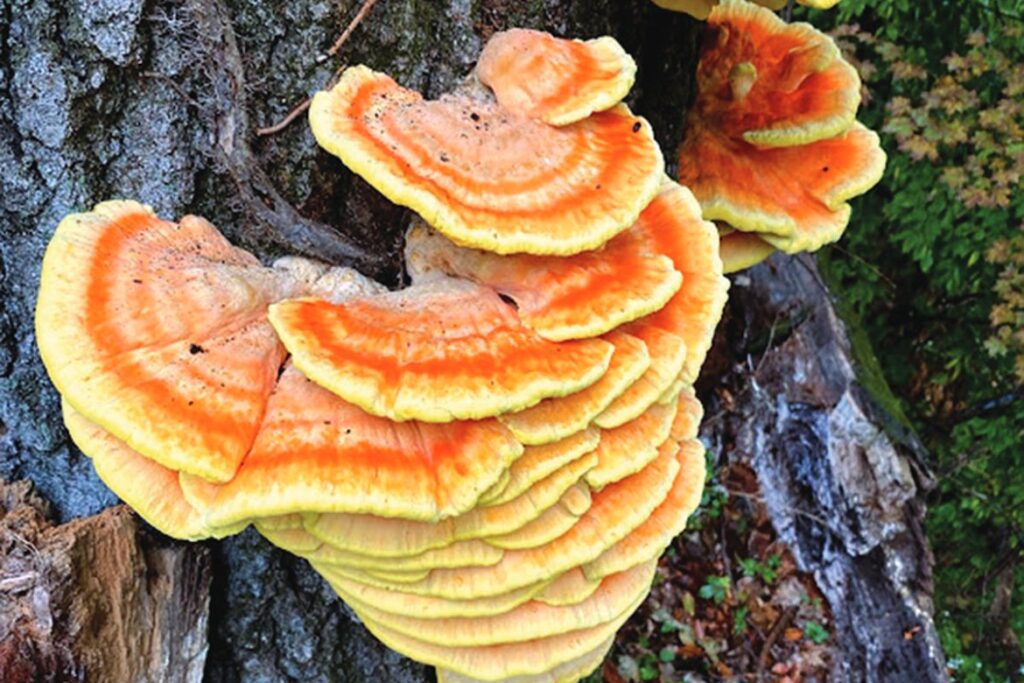
Chicken of the Woods (Photo by Wildspawn Mushroom)
Rich in vitamins, antioxidants, minerals, protein, and essential amino acids, fungi have a giant vocabulary in the culinary world. As scientists learn more about fungi, Michelin-starred chefs, mixologists, manufacturers, and other players across the food chain are having a field day with fungal fruits, including exploring new frontiers in nutrition, medicine, and sustainability.
An estimated 2,100 mushrooms are safe to eat. Bringing unique aromas and flavors to a broad spectrum of dishes, their globe-spanning diversity, often steeped in legend and lore, is remarkable. The most common is the versatile button or white mushroom, which, depending on size, also goes by baby bella, cremini, and portobello. Favored by King Louis XIV, the related “Champignon de Paris” (Paris mushroom) was originally cultivated in the city’s catacombs.
Celebrated in Japan as the “dancing (nymph) mushroom” for its nutritional and health properties, the maitake, or Hen of the Woods, is among several master meat mimics. Named for their distinctive red color and shellfish-like odor, lobster mushrooms taste like mild white fish.
Prized for its singular flavor, the inimitable truffle has a high seat, albeit underground, in the edible fungi kingdom. Foodies also love huitlacoche, a velvety blue-black sporous fungus that grows on ears of corn. Also known as corn smut or Mexican truffle, this pungent spreadable delicacy adds decadence to a range of dishes.
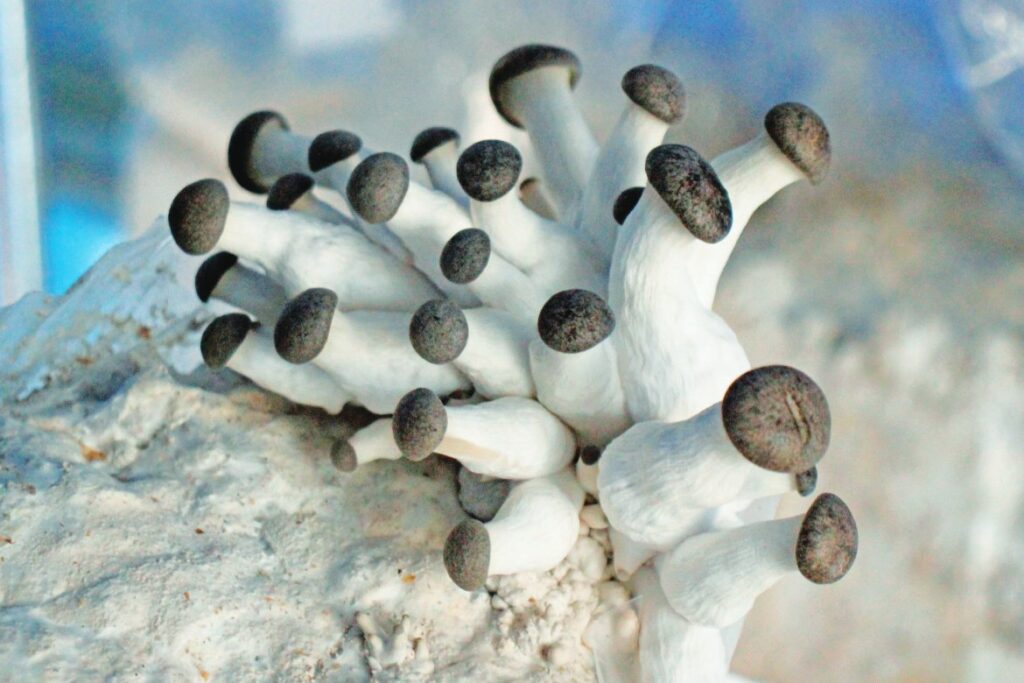

Blue oyster mushrooms (Photo by Jeff Heilman)
Caterpillar fungus wear the crown though. Found only on the Tibetan plateau, where it is known as yartsa gunbu (summer grass, winter worm), this Cordyceps family member, the zombie fungus from HBO’s hit The Last of Us, parasitically invades, mummifies, and emerges from the larvae of ghost moths.
Used for centuries in traditional Chinese medicine, this high-priced rarity is also known as “Himalayan Viagra” for its purported prowess-enhancing effects. Feeling adventurous? NYC’s oldest Himalayan restaurant, award-winning Himalayan Yak (72-20 Roosevelt Avenue, Queens, NY. Tel: 718-779-1119.
himalayanyakny.com) serves yarsa gumba tea.
Mushrooms are also big business. According to Expert Market Research, the worldwide mushroom market reached nearly $63 billion in 2022 and is projected to exceed $100 billion by 2028. Led by China, the Asia Pacific region is the world’s largest mushroom producer.
Ten countries, including Poland, the Netherlands, Spain, France, and Italy, produce 90 percent all European mushrooms Grown in all 50 states, U.S. mushrooms are headquartered in Pennsylvania’s Kennett Square. Located west of Philadelphia, the self-proclaimed “Mushroom Capital of the World” and surrounding Chester County produce 65 percent of America’s mushrooms.
Celebrating its 39th edition in September 2024, the historic town’s annual two-day Mushroom Festival (mushroomfestival.org) attracts thousands of visitors. Signature local dishes include the roasted mushroom soup with madeira wine and fried shallots at Portabellos of Kennett Square (108 East State Street. Tel.: 610.925.4984. portabellosofkennettsquare.com). Another favorite is the creamy mac and cheese with local mushrooms at, gourmet market by day, restaurant by night, Talula’s Table (102 W. State Street. Tel: 610- 444-8255. talulastable.com).
Alongside traditional culinary uses, the sustainable food movement is driving market demand. Described by the NJ-based Food Institute as “fungi fever” and the “Shroom Boom,” mushrooms and mycelium based products are fast-rising stars in global efforts to reduce meat consumption and move to natural, minimally processed plant-based products.
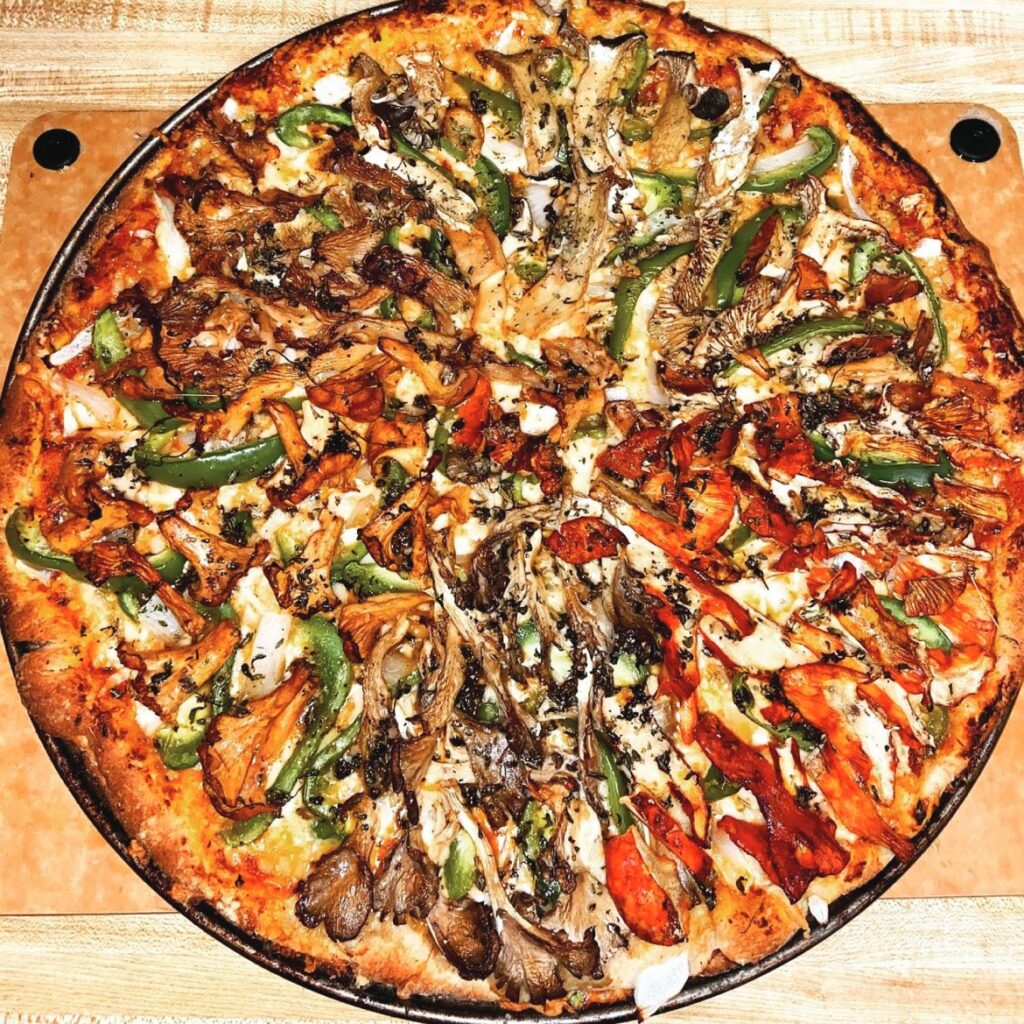

Mushroom Pizza (Photo by Jeff Mertz)
“Requiring mere fractions of the water, land, energy, and other resources required by plant, crop, and livestock farming, with zero or minimal carbon emissions, mushrooms are one of the most sustainable of all agricultural products,” said Shaw Civitarese, a food scientist experienced in mycology. “With a cellular structure that closely mimics animal tissue, mycelium has the potential, as a substitute for meat, poultry, dairy, and other products, to become a completely renewable resource that can significantly help the environment and bring protein sources to under-served people in food deserts around the world.”
As the expanding global plant-based food industry makes inroads with consumers, winning on taste is a key to lasting impact. Front-runners include mushrooms rich in umami, Japanese for “savoriness” or “deliciousness”.
“Containing glutamate, an amino acid and building block of protein, umami is among them most coveted of the five taste senses,” said Civitarese. “Yet it rarely occurs in nature outside of meat, which makes umami-rich mushrooms like maitake, shiitake, and king trumpet compelling substitutes with a meaty richness that kicks your taste buds into high gear.”
Case in point was my surpassing maitake dish at the 2023 edition of RAW:almond (raw-almond.com) in Winnipeg, Canada, the city’s signature culinary event featuring gourmet cuisine from star chefs in a tent on a frozen river.
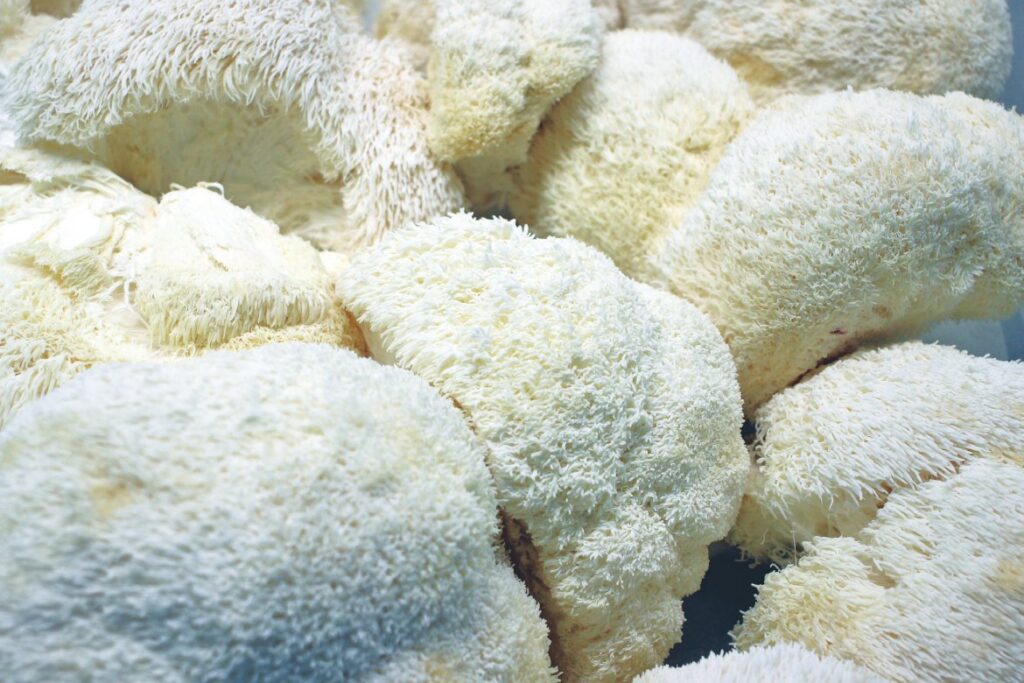

Lion’s mane at Wildspawn Mushrooms farm (Photo by Jeff Heilman)
I swore I was eating steak marinated in teriyaki and pineapple juice, but it was Chef Christine Sandford’s wood-fired maitake, steeped in lacto-fermented maitake bouillon, mushroom stock, and allium oil. Bathed in the sweet, garlicky broth, the meaty, peppery, smoky taste of the maitake was an all-time high.
Count Eric Ripert, the worldrenowned chef and co-owner of NYC’s Michelin three-star Le Bernardin (155 W. 51st Street. Tel: 212-554-1515. le-bernardin.com), among the fungi faithful. Speaking at the September 2023 Plant Based World Expo North America in NYC on a panel titled “Meat Mushrooms, Your New Center of the Plate Protein,” Ripert discussed his consultative role as Culinary Advisor to Chicago-based alternative food company Nature’s Fynd.
The company’s core product, Fy, was born of a microbe discovered by NASA-backed scientists in an acidic Yellowstone National Park hot spring. The team then developed breakthrough fermentation technology to produce a revolutionary new nutritional fungi protein that acts like a sourdough starter without rain, sun, or soil.
First getting Ripert’s attention was their Fy-based cream cheese, which he described as “the closest to the traditional dairy-made version that I have tasted.” He was equally impressed by their breakfast sausage, chocolate mousse, and Camembert cheese that the discerning Frenchman called “indistinguishable” from the real thing.
“In 48 hours, they can create the equivalent protein of 30 chickens with very little water and no pesticides, insecticides, GMO, and killing,” said Ripert. “But I am tough with them to make sure their creations are absolutely delicious.”
Fy-based dishes making the grade at Le Bernardin, named the number one restaurant in the U.S. and worldwide by La Liste in 2023, have included cheesecake and ice cream desserts using Nature’s Fynd cream cheese, along with saffron risotto, stuffed zucchini flowers, and salad dressings.
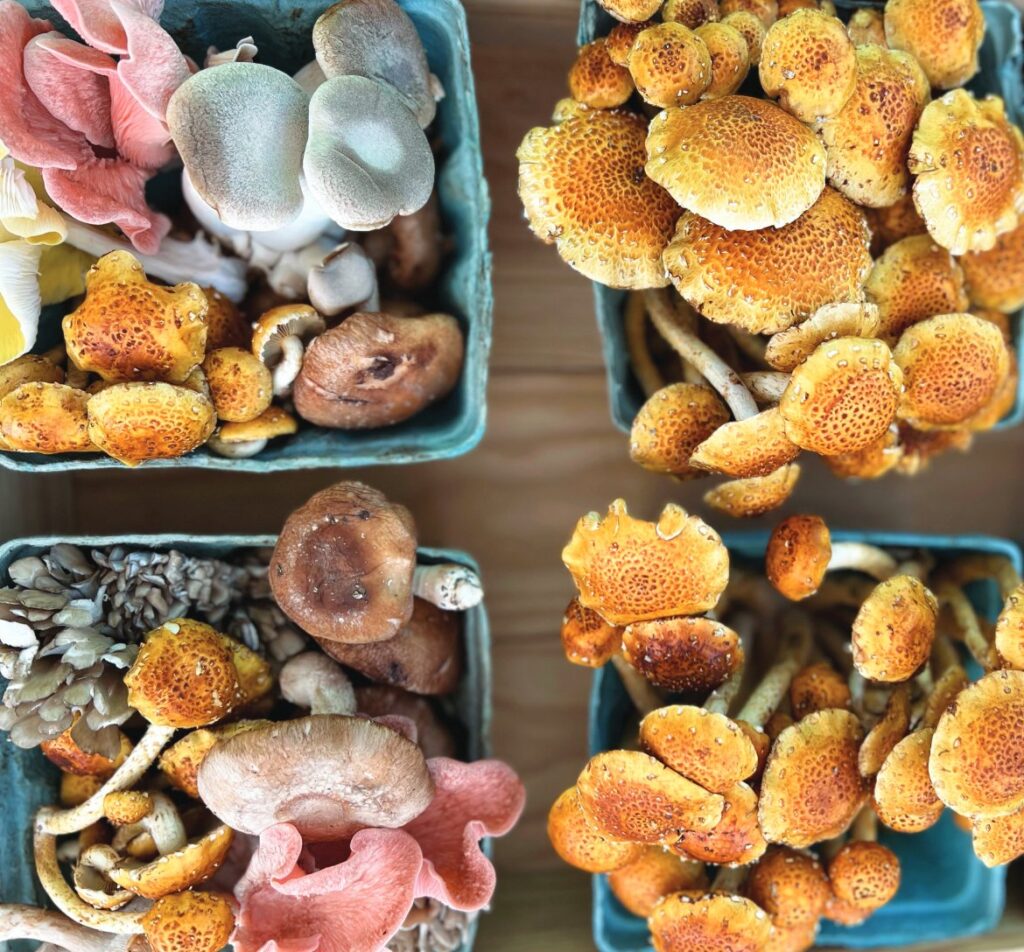

Foraged wild mushrooms (Photo by Wildspawn Mushrooms)
“It’s everything one would want in a fine restaurant,” said Julia Child of Pot Au Feu Bistro in Providence, R.I. (44 Custom House Street. Tel: 401-273-8953. potaufeuri.com). Today, America’s oldest French bistro (from 1972) is also known for foraged fungi from Executive Chef Spike Mikulski, Rhode Island’s only certified mushroom expert. His signature Soupe aux Champignons Sauvage, or Creamy Wild Mushroom Soup, is a veritable party of seasonal mushrooms including black trumpet, porcini, maitake, hedgehog, and oyster. With two Vermont locations, Hen of the Wood (14 S Main St., Waterbury, VT. Tel: 802-244-7300. henofthewood.com/waterbury) serves divine Hen of the Woods mushroom toast on grilled bread with house bacon and poached egg.
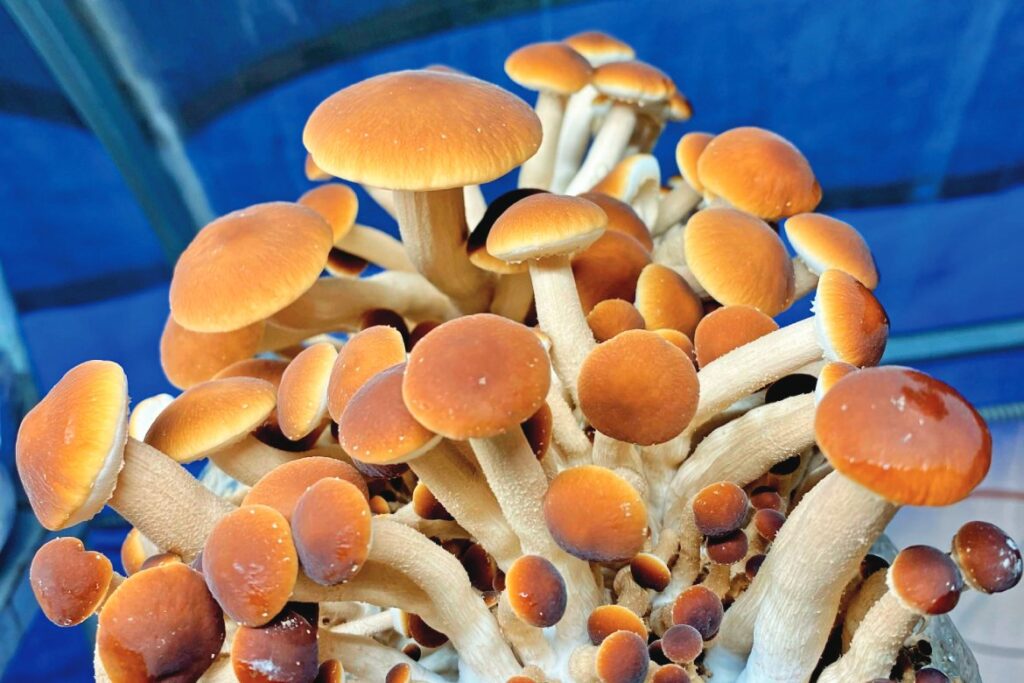

Pioppino mushrooms (Photo by Wildspawn Mushrooms)
At Poggio Trattoria (777 Bridgeway. Tel: 415-332-7771. poggiotrattoria.com) in Sausalito, California., Executive Chef Benjamin Balesteri flavors his Italian menu with chanterelles, pioppini, maitake, and other mushrooms. Babines (15 Rue de Nancy. Tel: +33-6459-70401. babinesparis.fr) in Paris does amazing seasonal truffle and morel fondues. In Brussels’ hip Saint Gilles neighborhood, Café des Spores (Alsembergsesteenweg 103. Tel: +32-2534-1303. cafedesspores.be/en) goes full mushroom with natural wine pairings.
Meanwhile, Tuscany is fungi heaven with restaurants to match, such as La Grotta Guelfa (Via Pellicceria 5R, Piazzetta Di Parte Guelfa. Tel: +39-055-210-042. grottaguelfa.it) in Florence, a top draw for truffle beef tartare, truffle risotto, tagliolini with porcini, and other delights. Rooted in ancient Western and Eastern medicinal culture, fungi’s potent therapeutic powers are in the bloom of a decade-long renaissance.
As pioneering mycologist Paul Stamets, founder of acclaimed mycelium-based supplement company Host Defense Mushrooms, noted in a 2014 paper, “modern science (has) rediscovered what the ancients knew long ago, that mushrooms can be deep reservoirs of powerful medicines.”
Psilocybin, the active chemical in psychedelic mushrooms, is helping to ease depression, anxiety, and other mental health conditions. Researchers are also buzzing about mushrooms with adaptogens, or substances that alleviate stress, energize the body, and promote health.
Advancing research is finding that these so-called “functional” fungi, which include lion’s mane, maitake, chaga, king trumpet, turkey tail, and rishi (The Mushroom of Immortality in ancient China) may boost brain function, kill cancer cells, reduce gut inflammation, and improve sleep.
Deployed as supplements, tonics, tinctures, liquid extracts, powders, and blends in coffee, tea, and smoothies, adaptogenic mushrooms are also making a splash on cocktail menus.


Mariena Mercer Boarini (Photo by Studio J)
As Master Mixologist of Wynn Resorts, North America (wynnresorts.com), Mariena Mercer Boarini oversees the cocktail programs at the 30-plus bars and restaurants throughout Wynn and Encore Las Vegas, as well as Encore Boston Harbor. Schooled in chemistry and with “wonder and magic” as her “spirit” guides, the acclaimed Las Vegas native is bringing mushrooms into her imaginative craft cocktails.
“Mushrooms spored into my life in multi-faceted ways,” said Mercer Boarini. “Constantly seeking novel and innovative ingredients to capture our guests’ imaginations and seduce their senses, I love adding savory notes to cocktails while imparting depth and nuance. I also adore cooking in the well ness sector. Mushrooms provide the perfect avenue for these directions.”
Mixing with mushrooms is not unlike mixing with spirits, tea, or herbs. “Each type has its own distinct flavor profile,” continued Mercer Boarini, who builds her cocktails one flavor at a time. “The umami notes of mushrooms perfectly balance with well-known sweet, citrus, or bitter ingredients. Chaga, for example, contains vanillin, which mimics vanilla flavor. Adding the finesse of an oak barrel, I reinforce those flavors by mixing them with whiskeys and aged tequilas.”


The Solar Power at the Wynn (Photo by Sabin Orr)
Developed for her “Drink Well” zero proof cocktail program at Wynn, The Solar Power is her play on mushroom coffee. “I blend lion’s mane and rishi mushrooms with La Colombe coffee, almond milk, maca and natural cacao for an adaptogenic beverage that provides natural energy and mental clarity,”
Mercer Boarini said. “The reishi’s earthiness and the coffee’s bitterness pair perfectly with the cacao’s chocolate notes. Reishi also stands up to an herbal or bitter elixir, while the sweet, delicate lion’s mane matches well with fortified wines
or sake.”
Her mushroom mixology is a hit with guests. “While nascent and unexpected on most cocktail menus, the gospel of their health benefits is helping mushrooms cross over into uses beyond culinary,” said Mercer Boarini. “I plan on working mushrooms into future creations, as the opportunities are endless.”
A Foraging Feast
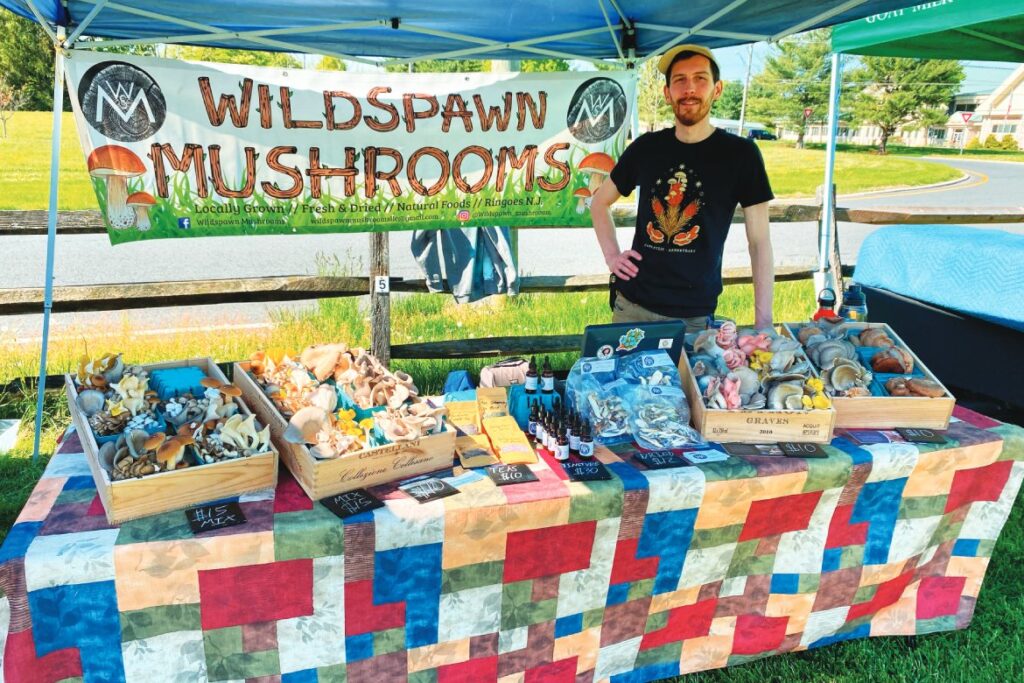

Jeff Mertz (Photo by Wildspawn Mushrooms)
Sharing a passion for nature and foraging for food in the wild, friends Jeff Mertz and former partner Cody Iannozzi founded Wildspawn Mushrooms (Tel: 561-945-4702. wildspawnmushrooms.com) in 2021, specializing in cultivating and selling choice edible mushrooms, along with foraging education. I recently met Mertz at his small-scale farm in New Jersey’s agrarian-rich Hunterdon County to learn about mushroom properties and foraging. “Button, oyster, and shiitake mushrooms are more easily sourced in stores, while exotic varieties such as nameko and lion’s mane are only available from small mushroom farms,” informed Mertz, who cultivates more than 10 different culinary and medicinal mushrooms which he sells to local restaurants and at farmers markets.
Foraging expands the field, including crowd favorites like chanterelles and morels— but know before you go. “North America is home to some 250 poisonous mushrooms, like the notorious Death Cap and Destroying Angel,” Mertz said. “Deadly mushrooms are often mistaken for edible ones, such as the Jack-o’-Lantern, which resembles the chanterelle, and false morels. Certain edible wild mushrooms, like beech and Chicken of the Woods, require thorough cooking to ease digestion.”
Mertz, who offers seasonal foraging classes, recommends learning from a professional. “It takes time and hands-on experience,” he said Mertz. “Nuances abound, from color differences to cap, gill, and stalk structures, which makes learning in the field far more valuable than watching Tik-Tok or YouTube videos.” Prized finds include lion’s mane.“Also known as the bearded tooth or pompom mushroom for its fine ‘teeth,’ lion’s mane has been shown to accelerate the growth of brain cells and kill cancer cells,” said Mertz. “It is also delicious, echoing crab meat when flaked or shredded and crisping up nicely when fried.”
Other foraged favorites include beech and chestnut mushrooms, both favored by chefs for their firmness and flavor, and Chicken of the Woods, which resembles chicken breast in texture and taste.
Cultivated mushrooms such as blue and king oysters likewise mix versatility with health benefits. “Taking on stronger flavors like ginger and fresh herbs, oyster mushrooms work great as a simple saute with garlic and butter, as well as an ingredient in soups, stews, and sauces,” continued Mertz. “Possessing antimicrobial, anti-inflammatory, and free-radical fighting properties, they increase immunity and help to reduce obesity, diabetes, heart disease, and colon and breast cancers.”
Mertz’s other artful cultivars include the white-stemmed, brown capped velvet pioppino. Rich in metabolites, copper, fiber, and vitamin B5, they add a meaty, slightly sweet crunch to pastas, soups, stews, sauces, risotto, and braised dishes. Beloved in Japan, the nameko’s buttery scent and slight sweetness pair with pizza, stir-fry, steak, soup, and ramen. “Some of my favorite recipes include Sweet Soy Glazed Shiitake and the Pulled King Oyster Sandwich, my take on the BBQ classic pulled pork,” said Mertz. “Mushrooms offer many creative possibilities in the kitchen, which is part of the fun.”
You may also enjoy
Vegan, Vegetarian Dining Options In New York City
Worldeats: Vegan, Vegetarian, and Organic Dining Options, New York, New York


